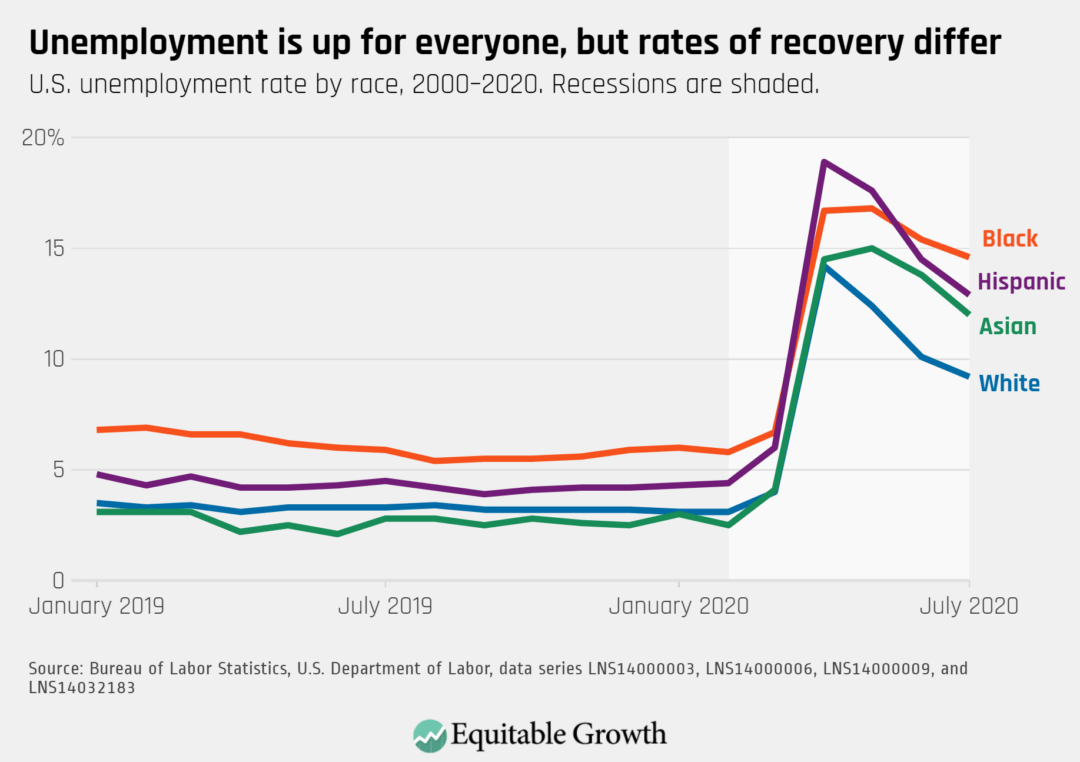July jobs report: Coronavirus recession continues to hit Latinx workers in service jobs amid unprecedented U.S. labor market volatility

With novel coronavirus infections still rising in many states, an ongoing squeeze on already hard-hit workers and businesses, and uncertainty about the federal government’s next economic relief package, July’s Employment Situation Summary by the U.S. Bureau of Labor Statistics shows that the labor market lost some of its momentum toward recovery compared to May and June. And women workers, Asian, Black, and Latinx workers, and workers with lower levels of education are all continuing to experience particularly high rates of unemployment.
After record job losses in April followed by strong employment gains in May and June, the U.S. economy recovered1.8million jobs in July. The share of prime-aged adults who have a job ticked up from 73.5 percent to 73.8 percent, and the overall unemployment rate fell to 10.2 percent—a 0.9 percentage point decline from the previous month. The share of unemployed workers who report having permanently lost their jobs rather than being on a temporary layoff rose for the fourth month in a row, albeit less so than in June and May, going from 20.9 percent in June to 22.6 percentin July.
Small sample sizes in the Bureau of Labor Statistics’ jobs survey mean month-to-month changes should be interpreted with caution, yet the disparities by race and ethnicity are striking. Between June and July the unemployment rate for Black workers fell the most slowly among workers of color, going from 15.4 percent to 14.6 percent. For Asian American workers it declined from 13.8 percent to 12 percent. White workers’ jobless rate fell from 10.1 percent in June to 9.2 percent in July. (See Figure 1.)
Figure 1

The labor market has been particularly volatile for Latinx workers. In April, their unemployment rate shot up, reaching an all-time high of 18.9 percent—6.9 percentage points higher than at its Great Recession peak in August 2009. But the Latinx unemployment rate has been falling relatively quickly since then, dropping from 14.5 percent in June to 12.9 percent in July.
These sharp fluctuations are explained, in part, by the economic downturn’s impact on service jobs. Since the coronavirus recession hit, service industries have borne the brunt of job losses, with the leisure and hospitality industry leading the way. Between February and April the sector lost 8.3 million jobs—almost 50 percent of its pre-pandemic employment. Yet in the last 3 months the leisure and hospitality industry has also made some of the strongest gains. Despite surging coronavirus cases dampening usual summer activities, in July hospitality and leisure accounted for more than a third of all new jobs, more than any other industry, followed by government, retail, and education and health services.
For Latinx workers, these job losses and gains have big implications, since they are overrepresented in service industries and occupations. Despite making up 17.6 percent of the U.S. workforce, Latinx workers constitute 24 percent of the leisure and hospitality industry. In 2019, almost 1 in 3 Latinas and 1 in 4 Latinos worked in service occupations such as housekeepers, medical assistants, and cooks, higher than the proportion of White men and women and Black men and women in service occupations. (See Figure 2.)
Figure 2

Because many of these service jobs require face-to-face interactions, the percent of Latinx workers who were able to telework for pay at any time in June was only 21.1 percent—a smaller share than workers of any other major racial or ethnic group.
The crisis in the service sector is compounded by Latinx workers’ overrepresentation in low-wage jobs. They have the lowest median earnings of any major ethnic or racial group. Breaking the data down by gender, Latinas are the worst paid workers in the U.S. economy.
When analyzing differences in pay, researchers find that there is, on average, a 40-cent wage gap between Latinas and White men. Occupational segregation explains an important chunk of the gap, followed by disparities in education and training, and industry distribution. More than half of the pay gap between Latinas and White men, however, is unexplained by other demographic or human capital variables, and interpreted as evidence of discrimination in the U.S. labor market.
Additionally, some of the decline in the Latinx unemployment rate is probably a consequence of many of these workers dropping out of the labor force altogether. Between June and July the Latinx labor force participation rate—the share of people employed or actively looking for a job—fell more than for any other group, dropping from 65.5 percent to 64.6 percent.
This exit from the U.S. labor force risks erasing some of the gains made by Latinas during the 2009–2020 expansion. As early as a decade ago, Latinas used to have the lowest labor force participation rate in the United States, but by February 2020, just before the coronavirus recession hit, their unadjusted labor force participation rate reached 59.4 percent—higher than the rate for women overall and the highest point since the statistic was first reported in 1976. In July, however, the share of Latinas who are either employed or actively looking for a job dropped from 59.3 percent in June to 58.5 percent in July.
The U.S. labor market is far from roaring back. Many of the jobs created last month—particularly those in service occupations—are worse and less safe than the jobs that were lost in March and April. Uncertainty and lack of support for workers who have been hardest hit by the coronavirus recession are already putting the brakes on the recovery. The expiration of the weekly $600 Pandemic Unemployment Compensation boost at the end of July is particularly painful for low-wage workers in the most exposed industries. Even though it will now take weeks before any further enhancements to jobless benefits reach workers, policymakers should extend the extra $600 and only phase them out once the unemployment rate falls and the health crisis is kept in check. As long as both workers and consumers feel unsafe, the recovery will stall.






